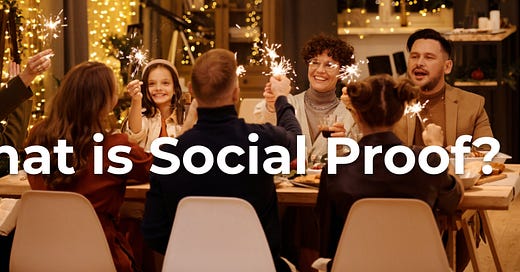Social Proof
The greater the number of people who find any idea correct, the more the idea will be correct - Robert B. Cialdini
Hello Readers,
Welcome to the latest edition of CAPTIVATE! If you're new, welcome. Every month, we bring you one tip to improve your communication skills through the power of persuasion, negotiation and storytelling. We scour the research on psychology, behavioral economics and influence to bring you the most actionable ways to increase your impact.
Our Promise - keep it CIA. Concise, Insightful and Actionable!
Today's tip, Social Proof.
Ever find yourself in a new setting, feeling a bit lost on how to navigate it? More than likely, you scanned the room, observed what others were doing, and then followed their lead.
This is social proof at play; a psychological concept where people tend to adopt the behaviours or beliefs of others in uncertain situations, craving the comfort and approval of social validation. Often, individuals simply rely on observing and imitating others to make decisions.
From wearing a mask during Covid to how you behave on the first day of a new job, social proof is everywhere. The concept also holds great potential for influence and persuasion. Showcasing social proof for a specific action instantly makes it more enticing.
But if people love to show off their individuality, why is social proof so effective?
When information is scarce, we assume others know more, making their choices worthy of mimicking.
There is safety in numbers. People are risk averse, so if everyone else is aligned, it is perceived as a safe choice.
Understanding social proof reveals its pervasive role in persuasion.
What Others Do and Say
It is standard practice for every ecommerce site to include product reviews (95% of customers read reviews before making a purchase), providing social proof of how great a product is. In the B2B world, this takes the form of case studies, testimonials or the wall of customer logos. We also see people adding creativity and urgency to their social proof, like the travel site signalling a popular trip that could sell out, or a restaurant flaunting the ‘favourites’ on the menu.
Benchmarks and Data
Beyond showing social proof from individuals, you can also highlight the collective behaviour, such as the newsletter boasting thousands or readers, or a sales pitch showing an industry benchmark. Both of these show social proof at scale (and combine nicely with Loss Aversion).
People Like Me
Even more powerful than showing what others do is social proof from people like your target audience. Whether it’s car reviews tailored specifically to parents or a case study aimed at your industry, relatability nurtures trust. Making use of ‘brand ambassadors’ further emphasizes that people like you endorse their product.
What do you do if you are launching something new and don’t have reviews or testimonials yet? This is a common challenge.
Don’t fake it. Ever. Apart from being morally wrong, prospective customers can smell deception from a mile away. Rather, consider giving away your product to a handful of prospects in return for those early reviews. Ideally, find someone that holds influence in your target market and be sure you give them an incredible experience. Social proof will follow.
In the next meeting when you need to convince your counterpart, line up some quotes or reviews from their peer group to demonstrate social proof for your idea. This may be either an internal meeting or an external client pitch.
If you are in B2C, push yourself to go beyond simple product reviews and find a more creative or targeted way to use social proof to drive customer action.
Want to Learn More? Check out these Great Resources:
While many studies have shown the impact of social proof, the term itself was coined by Robert Cialdini in his famous book Influence: The Psychology of Persuasion.
For a more tactical view of social proof, pick up Using Behavioural Science in Marketing, by Nancy Harhut. If you are looking for something more lighthearted, this 3 minute video shows social proof in action.
Did you enjoy this edition of Captivate? Subscribe and pass it on to a friend.
We look forward to seeing you in the new year!






